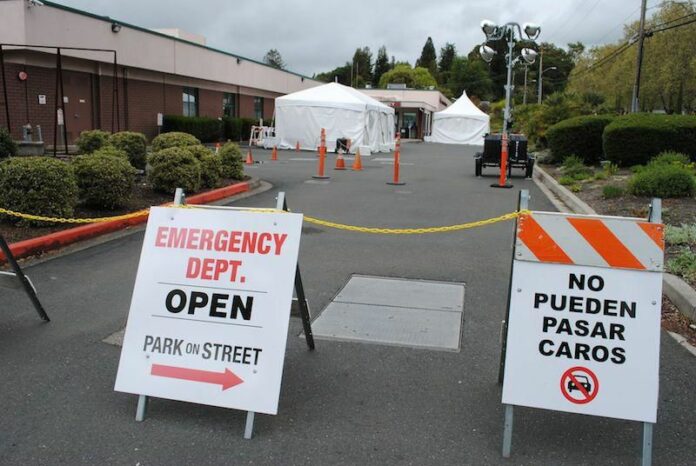North county district may partner with St. Joseph’s, but with it may come rules on health care choices
Healdsburg District Hospital is still moving forward with a possible management deal with St. Joseph’s Health Northern California, though religious concerns have been raised.
The North Sonoma County Healthcare District board met for a special meeting on Aug. 15 at the Healdsburg District Hospital business offices to discuss the possible memorandum of understanding (MOU) among other items.
The MOU would place St. Joseph’s Health as the management company for the hospital, possibly through a joint operating company created with Adventist Health.
District attorney Bill Arnone said that talks to that end, however, may be hitting a wall. He said that St. Joseph’s may not decide to allow the joint operating company to manage the hospital, as is the case with St. Joseph’s relationship with Petaluma Valley.
The reason the joint operating company’s management of the hospital over solely St. Joseph’s is important to the district is the possibility of having to follow St. Joseph’s religious directives.
If the joint company runs the hospital through the MOU, then it is unlikely the hospital will have to follow the directives, but if St. Joseph’s runs management, it likely will.
The religious directives follow Catholic principals and would affect reproductive health care and end-of-life care. As examples, abortion services and assisted suicide for the terminally ill — often referred to as “dignity in dying” by proponents — would not be allowed regardless of laws at the time. Religious directives are not limited to these items, though, and are at the discretion of Catholic leadership.
The board expressed its desire to continue to push for a management of the hospital that would not follow religious directives as negotiations continue.
The board also wanted to know why Petaluma Valley was allowed to operate free of religious directives under a joint operating company while the Healdsburg district may not be able to.
“There wasn’t a real convincing discussion,” about the topic, Arnone said.
Board members E.J. Neil and Erin Gore had also spoken with St. Joseph’s the day before, but had not been told the reasoning behind the change in policy, either.
In addition, a review for approval of the joint operating company between St. Joseph’s and Adventist Health has been in the State Attorney General’s office for some time and could potentially alter talks depending on the outcome. The joint operating company is expected to be approved by September and “live” in October. Arnone said that any potential deal cannot be consummated until this happens.
The MOU was formed and signed July 10, 2018, to help the district financially and to improve access to care, according to the document.
The MOU would allow St. Joseph’s to lease the hospital for will have the opportunity to purchase the hospital at certain intervals, though the terms of the sale would still need to be negotiated and put before voters for approval.
Management of the hospital would be comprehensive, and includes clinics and others leasing at the hospital.
St. Joseph’s may also improve seismic upgrades at the hospital, part of the deferred maintenance of the building. The larger network of St. Joseph’s is also put forth as a way to bring in doctors and achieve efficiencies.
In a review of the Physician Needs Assessment, district CEO Joe Harrington said that the district shows a need for doctors in cardiology, dermatology and primary care, though these may not necessarily be at the hospital. He did say, though, that having this review would help show St. Joseph’s, or any potential partner, assess how it could help the district fill its needs.
Subacute presentation
The district also heard a presentation from Nurse Manager Celia Palasio on the operations of its Subacute Unit in the Skilled Nursing Facility.
The unit typically houses patients who have suffered a traumatic event such as a stroke or head injury that has left them unable to care for themselves. Typically, these patients die in care.
Palasio said there are strict criteria for admitting a patient to the unit laid forth by California’s MediCal.
In order to be admitted, patients must have a combination of two or more of the following: a tracheostomy and feeding tube; extensive wound care; and total parenteral nutrition. If one condition goes away, such as the wound care, a patient may have to be discharged from the unit.
Palasio commended her staff not just for their level of care, but for their work with families of patients. Often, it is left to the staff to help families understand the reality that their loved ones will likely not get better. She did emphasize, however, that they did not try to take away hope.
The unit has a staff of 47 with 17 patients. The average stay for a patient is four to six years. Seven of the current patients are locals.
Palasio said they have seen successes in low infection rates and positive survey results from patient’s families. Resident patients also have a longer lifespan than the average in comparable units across the country.
Finding patients that match the necessary criteria and covering necessary shifts for doctors were a couple of the challenges they faced.
Board member Dr. David Anderson also commended the staff on the low infection rates, particularly since catheters are often used in the unit and raise the risk of infection significantly.
He was also impressed by the “almost none” answer for the amount of bedsores for patients, as many patients are unable to move.
Healdsburg District Hospital business offices are located at 190 Foss Creek Circle, Suite F. The board typically meets the last Thursday of the month.
50.7
F
Healdsburg
April 19, 2025








